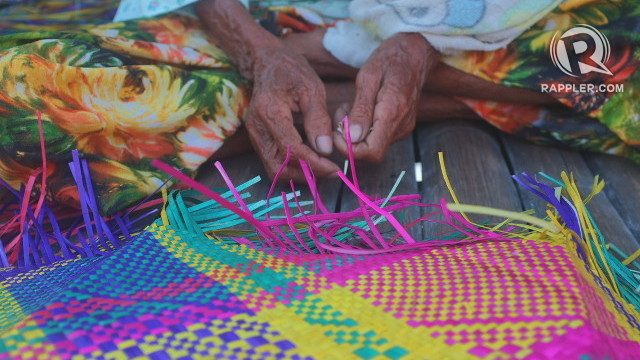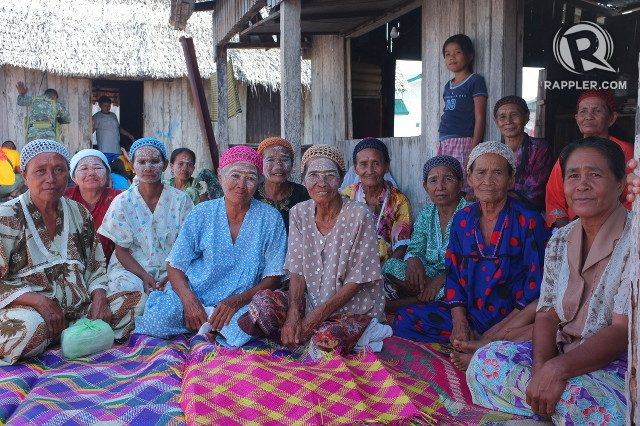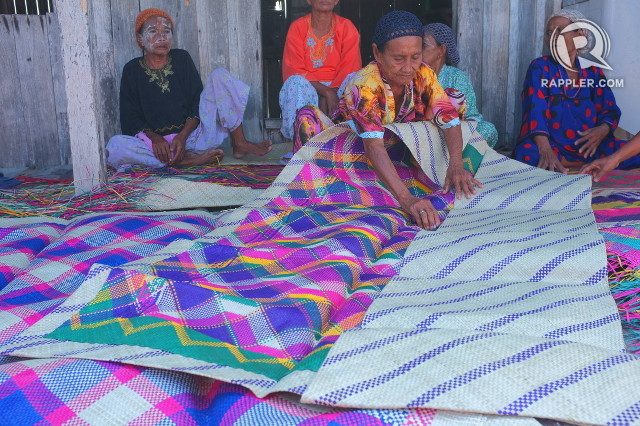SUMMARY
This is AI generated summarization, which may have errors. For context, always refer to the full article.

BONGAO, Philippines – The mats and their weavers were a riot of color.
Surrounded by the dull gray of well-worn wood, the basic building material of the Sama Dilaut’s stilt houses, they were like flowers popping from a background of soil.
In Panglimasugala, Tawi-Tawi, around 15 weavers were gathered around and sitting on top of their creations – the mysterious and much sought-after baloy. Baloy is the term they use to refer to fantastically-hued mats made of dyed pandan leaf strips.
The Sama Dilaut women weave them from inside their houses. But today, they had all brought their mats to the same wooden platform for our group to see.
The eldest of the group, 70-year-old Gainab Norkarim, said she began weaving at the age of 50, after her husband died.
Her brown fingers deftly lifted one strip over the other, as carefully as if she were braiding her daughter’s hair.
She said it takes two months to finish a baloy – if there is no other work to do.
“Matagal, mahirap mag-gawa ng banig (It takes long, it’s difficult to make a mat),” she said.
Women in her village of Balimbing now usually buy the pandan strips and the dye. But in their younger days, they would cut the pandan leaves themselves, dry them, and soak them in dye.

Only then would they begin the meticulous process of arranging the multi-colored strips into eye-popping geometric patterns.
Norkarim gets inspiration from everything she sees.
“Kung mayroon makita ko, matingin ko, ito lang ako, marunong mag-design (If I see something, if I look at something, this is all I know, how to design),” she said.
It’s no wonder the undulating patterns remind one of waves, or of sunlight reflecting on water. The Sama Dilaut are a semi-nomadic tribe wandering the seas of the Sulu archipelago. They are often referred to as sea gypsies.
“You know where they get their design? It’s from the moon, from the sea, from the color of the sun, from the leaves, from the mountains they see. Their design comes from their own environment,” said Tawi-Tawi Representative Ruby Sahali.
Young blood
But Norkarim worries for the future of baloy weaving. Many young Sama Dilaut women are no longer interested in learning the skill.
“Wala na mga bata marunong mag-gawa ng banig na ito. Matanda na. Kung wala nang matanda, wala nang pagbaloy (None of the children know how to weave. It’s only the old. If the elders are gone, no one will be weaving),” she said.

Sama Dilaut women (the men do not weave traditionally) now spend most of their time away from the community to pursue studies in Bongao, Tawi-Tawi’s most urbanized town, or in Zamboanga City.
Norkarim understands. After all, she and the other mat weavers weave only during their spare time when all household chores are done.
They do it to augment their income. One full-sized mat costs around P2,500 ($55), said Norkarim.
To encourage the art form, the Tawi-Tawi local government buys the mats from the Sama Dilaut and sells them to tourists. Ensuring the profitability of mat weaving is the best way to keep it alive, said Sahali.
Sahali has a more optimistic take on the future of the baloy.
“It’s not like before when the women would stay at home all the time. Now they go to high school and college. But when they come back during the summer, they still do mat weaving. It won’t disappear. Even if the LGU does not intervene, it won’t just disappear,” she told Rappler.
It’s a comforting thought for cultures carried by the currents of change, continually shaped by the reality around them. – Rappler.com
Cinematography, editing by Franz Lopez
Add a comment
How does this make you feel?
There are no comments yet. Add your comment to start the conversation.